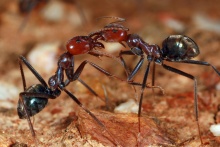Ritualised fighting in Iridomyrmex purpureus
The meat ant species Iridomyrmex purpureus is one the most abundant and obvious ants across much of southern Australia. They form large pebble-covered nests, with colonies consisting of numerous individual nests, these nests often connected by well-worn "highways". Colonies normally consist of about 7 individual nests but this can vary from only a single nest up to over a dozen nests, with a single queen per colony[1]. Nests are generally placed near food sources, minimising foraging times and making the colony more efficient, and colonies will abandon nests as food sources shift location[2][3].
A large nest mound of I. purpureus. Nests are most often found in relatively open areas with high light levels.
A well-worn highway connects two nests within a colony of I. purpureus.
It is well known that these ants are highly territorial with well defined boundaries being established between colonies[4]. These boundaries are not physical but are maintained by workers of neighboring colonies through highly stereotyped ritualised fighting, these confrontations sometimes lasting months and repeated over a number of years. These interactions are rarely fatal with the occasional minor injury being the most serious consequence for individual ants. While the vast majority of interactions between meat ant colonies are ritualised (some 95%), a few involve lethal fighting[5]. This lethal fighting seems to occur in situations where a foreign ant has invaded the territory of another colony and the fighting is initiated by the resident ant defending its colony. Thus these ants normally undertake ritualised fighting to establish and maintain colony boundaries with minimal injury to the colonies, but they will escalate to lethal fighting if their colony is under direct threat or attack.
Ritualised Fighting
Below is a flowchart of the interactions seen between workers involved in ritualised fighting. It should be noted that this is a rough guide and is not always followed. For example, appeasement can occur at most stages with the conflict ending, or stages can be undertaken for extended periods. In some cases stages may be skipped. Therefore, the following should be taken as a guide only and treated as typical but not the only pattern seen.
References
- ↑ van Wilgenburg, E., Mulder, R.A., Elgar, M.A. 2006. Intracolony relatedness and polydomy in the Australian meat ant, Iridomyrmex purpureus. Australian Journal of Zoology, 54, 117–122.
- ↑ Greaves, T., Hughes, R.D. 1974. The population biology of the meat ant. Journal of the Australian Entomological Society, 13, 329-351
- ↑ van Wilgenburg, E., Elgar, M.A. 2007. Colony structure and spatial distribution of food resources in the polydomous meat ant Iridomyrmex purpureus. Insectes Sociaux, 54, 5–10.
- ↑ Ettershank, G., Ettershank, J.A. 1982. Ritualised fighting in the meat ant Iridomyrmex purpureus (Smith) (Hymenoptera: Formicidae). Journal of the Australian Entomological Society, 21, 97-102.
- ↑ van Wilgenburg, E., van Lieshout, E., Elgar, M.A. 2005. Conflict resolution strategies in meat ants (Iridomyrmex purpureus): ritualised displays versus lethal fighting. Behaviour, 142, 701-716.
| ||||||||||||||||||||||||||











